您当前的位置:检测资讯 > 法规标准
嘉峪检测网 2025-08-22 08:18
近日,EDQM-OMCL发布《紫外 - 可见分光光度计确认指南》,包含Level III定期及有动机的仪器检查、紫外 - 可见分光光度计的建议及相关典型接受限、Level IV在用仪器检查、一般注意事项、光谱狭缝宽度(如适用)、波长精度、基线噪声、光度漂移等内容。文件将于9月1日生效。
ANNEX 3 OF THE OMCL NETWORK GUIDELINE “QUALIFICATION OF EQUIPMENT”
OMCL设备确认指南附录3
QUALIFICATION OF UV - VISIBLE SPECTROPHOTOMETERS
紫外-可见分光光度计的确认
Note: Mandatory requirements in this annex are defined using the terms “shall” or “must”. The use of “should” indicates a recommendation. For these parts of the text other appropriately justified approaches are acceptable. The term “can” indicates a possibility or an example with non - binding character.
注:本附件中的强制性要求使用 “应” 或 “必须” 等词来定义。“宜” 的使用表示一种建议。对于文本的这些部分,其他有适当理由的方法是可接受的。“可” 一词表示一种可能性或一个不具约束力的示例。
Table of Contents
目录
Introduction
简介
Level III. Periodic and motivated instrument checks
三级:定期及有动机的仪器检查
Recommendations for UV - visible spectrophotometers and related typical acceptance limits
紫外 - 可见分光光度计的建议及相关典型接受限
Level IV. In - use instrument checks
四级:使用中仪器检查
Recommendations for UV - visible spectrophotometers and related typical acceptance limits
紫外 - 可见分光光度计的建议及相关典型接受限
Level III. Periodic and motivated instrument checks
三级:定期及有动机的仪器检查
General Considerations
一般注意事项
Spectral Slit Width (if applicable)
光谱狭缝宽度(如适用)
Wavelength Precision (for mechanically set wavelengths)
波长精度(对于机械设定波长)
Baseline Noise
基线噪声
Photometric Drift
光度漂移
Level IV. In - use instrument checks
四级:使用中仪器检查
Introduction
简介
The present document is the 3rd Annex of the core document “Qualification of Equipment”, and it shall be used in combination with it when planning, performing and documenting the UV - Visible spectrophotometer qualification process.
本文件是核心文件 “设备确认” 的第 3 个附件,在规划、执行和记录紫外 - 可见分光光度计确认过程时,应与该核心文件结合使用。
The core document contains the Introduction and general forms for Level I (Selection of instruments and suppliers) and II (Installation and release for use) of qualification, which are common to all types of instruments.
核心文件包含一级(仪器和供应商的选择)和二级(安装和投入使用)确认的简介和通用表格,这些适用于所有类型的仪器。
The present Annex 3 contains the Introduction and requirements for UV - Visible spectrophotometers. Level III (Periodic and motivated instrument calibration/checks) and IV (In - use instrument checks) qualifications must be carried out being ISO/IEC 17025 requirement.
本附件 3 包含紫外 - 可见分光光度计的简介和要求。三级(定期及有动机的仪器校准 / 检查)和四级(使用中仪器检查)确认必须按照 ISO/IEC 17025 要求进行。
Requirements (if applicable) corresponding typical acceptance limits given in bold should be applied; however other appropriately justified approaches are acceptable.
应采用(如适用)以粗体给出的相应典型接受限;然而,其他有适当理由的方法也是可接受的。
Exemplary procedures provided in this document have non - binding character. They can be helpful to carry out the required qualification. Nevertheless, it is left to the professional judgement and background experience of each OMCL to decide on the most relevant procedures to be undertaken in order to give evidence that their UV-Visible spectrophotometers are working properly and aresuitable for their intended use.
本文件中提供的示例程序不具约束力。它们可能有助于进行所需的确认。然而,由每个 OMCL 根据专业判断和背景经验来决定采用最相关的程序,以证明其紫外 - 可见分光光度计工作正常且适合其预期用途。
If the qualification of equipment is done by the manufacturer or an external service - provider, it is the responsibility of the OMC L to make sure that this is in line with the requirements set out in this guideline.
如果设备的确认是由制造商或外部服务提供商完成的,那么 OMCL 有责任确保其符合本指南中规定的要求。
Level III. Periodic and motivated instrument checks
三级 定期及有动机的仪器检查
recommendations for UV - visible spectrometers and related typical acceptance limits
对紫外 - 可见分光光度计的建议及相关典型接受限度
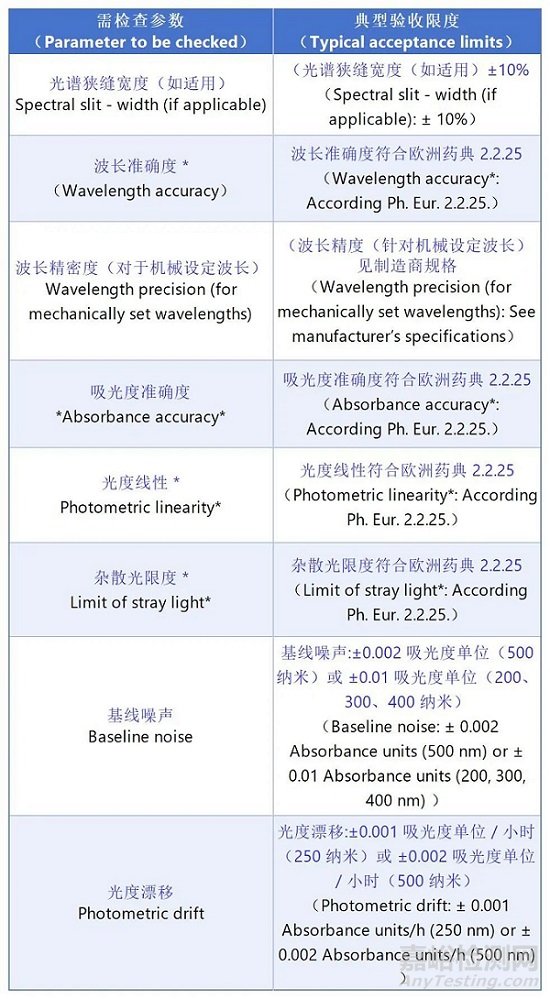
following the instructions given in Ph. Eur. Chapter 2.2.25. "Control of equipment performance"
遵循《欧洲药典》第 2.2.25 章 “设备性能控制” 中给出的说明
Level IV. In - use instrument checks
四级 使用中仪器的检查
Recommendations for UV - visible spectrophotometers and related typical acceptance limits
紫外 - 可见分光光度计的建议以及相关典型的可接受限度
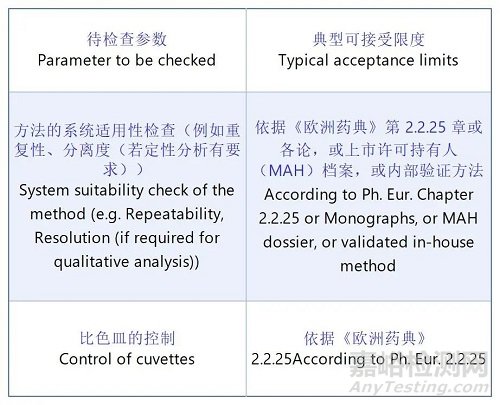
following the instructions given in Ph. Eur. Chapter 2.2.25. "Control of cuvettes"
按照欧洲药典第 2.2.25 章 “比色皿的控制” 中给出的说明操作
Level III. Periodic and motivated instrument checks
第三级:定期及有动机的仪器检查
This section contains practical examples of tests and their associated acceptance limits for several parameters related to the performance of a UV - visible spectrophotometer. These examples can be considered as the OPCs as possible approaches to perform the Level III of the equipment qualification process: "Periodic and motivated instrument checks".
本节包含了与紫外 - 可见分光光度计性能相关的几个参数的测试实例及其相关的合格限。这些实例可被视为执行设备确认过程第三级 “定期及有动机的仪器检查” 的可能方法(即操作规范条件)。
1.General Considerations
一般注意事项
Measurements made by comparing samples against external standards should be made under conditions during which temperature is held constant. This is particularly relevant where the carrier solvent is organic and measurements may be distorted by expansion or evaporation of the solvent.
通过将样品与外部标准进行比较而进行的测量应在温度保持恒定的条件下进行。这在载液为有机溶剂且测量可能因溶剂的膨胀或蒸发而失真的情况下尤为重要。
It is recommended to perform the qualification within the spectral range corresponding to the region of analytical interest.
建议在与分析感兴趣区域相对应的光谱范围内进行确认。
Ensure that the spectrophotometer has stabilised, according to the manufacturer's recommendations, before starting the qualification tests.
根据制造商的建议,在开始确认测试之前,确保分光光度计已稳定。
When references are made to the European Pharmacopoeia, e.g. reagents R, then reagent quality shall comply with the Ph. Eur. specifications.
当引用《欧洲药典》时,例如试剂 R,那么试剂质量应符合《欧洲药典》的规范。
When using commercial filters as alternative to the proposed tests, a set of filters covering the entire range of interest should be used. They should be calibrated with traceability to national/international standards, preferably through a national metrology laboratory or NIST.
当使用商业滤光片替代建议的测试时,应使用一组覆盖整个感兴趣范围的滤光片。它们应可溯源至国家 / 国际标准进行校准,最好通过国家计量实验室或美国国家标准与技术研究院(NIST)进行。
2.Spectral Slit Width (if applicable)
光谱狭缝宽度(如适用)
When using an instrument on which the slit - width is variable at the selected wavelength, the slit width must be small compared with the half - width of the absorption band but it must be as large as possible to obtain a high value of Ia. Therefore, a slit - width is chosen such that further reduction does not result in a change in absorbance reading.
当使用在选定波长下狭缝宽度可变的仪器时,狭缝宽度必须与吸收带的半宽度相比很小,但又必须尽可能大以获得高的 Ia 值。因此,选择的狭缝宽度应使得进一步减小不会导致吸光度读数的变化。
Method and Limits
方法和限度
1.Switch the system on and start the Scan module.
开启系统并启动扫描模块。
2.Select SETUP and set the following parameters:
选择 “设置” 并设置以下参数:
X Mode = Nanometers
X 模式 = 纳米
Start wavelength = 650.0 nm
起始波长 = 650.0 纳米
Stop wavelength = 660.0 nm
终止波长 = 660.0 纳米
Scan mode = Single
扫描模式 = 单次
Scan rate = 100 nm/min
扫描速率 = 100 纳米 / 分钟
Gain = (100) see 4 below
增益 = (100)见下面第 4 点
3.Select Options tab and set the following parameters:
选择 “选项” 选项卡并设置以下参数:
SWB = 4 nm
狭缝宽度带宽 = 4 纳米
Scan mode = Single front
扫描模式 = 单次前向
Lamps on = Deuterium
灯开启 = 氘灯
Source change = 700.0 nm
光源切换 = 700.0 纳米
4.Start a scan and examine the trace for a spectral peak around 656.1 nm. If no peak is seen or it is less than 50 % T, increase the gain.
开始扫描并检查在 656.1 纳米附近的光谱峰的轨迹。如果看不到峰或其小于 50% 透光度(T),则增加增益。
5.Measure the width of the peak (in nanometres) at half the height of the peak.
测量峰高一半处的峰宽(单位:纳米)。
This represents the spectral bandwidth and should be within ± 10% of that selected via the computer.
这代表光谱带宽,其值应在通过计算机选择的值的 ±10% 范围内。
6.Check the calibration at a slit width of 0.2 nm.
在狭缝宽度为 0.2 纳米时检查校准情况。
If the measured slits are too small then, for a selected width, the instrument will have more photometric noise than normal.
如果测量的狭缝过小,那么对于选定的宽度,仪器将产生比正常情况更多的光度噪声。
If the slit width is unacceptable, then reset the slit calibration.
如果狭缝宽度不可接受,则重置狭缝校准。
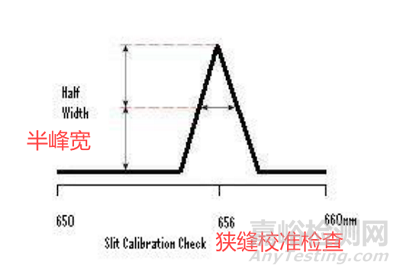
Effect of spectral slit width on absorbance fluctuation (performed with pure solvents).
光谱狭缝宽度对吸光度波动的影响(使用纯溶剂进行)。
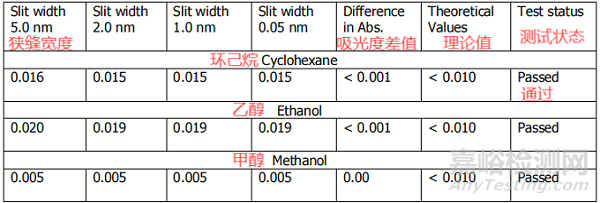
3.Wavelength Precision (for mechanically set wavelengths)
3. 波长精度(针对机械设定波长)
Materials:
材料:
For this test, the same materials of the previous test can be used: Holmium perchlorate solution R prepared, for example, with a 40 g/L solution of holmium oxide R in a solution of perchloric acid R containing 141 g/L of HClO4 (Ph. Eur. Chapter 4.1.1. "Reagents", ref. 1043101).
对于此测试,可以使用与之前测试相同的材料:例如,将氧化钬 R 的 40 g/L 溶液在含有 141 g/L 高氯酸(HClO4)的高氯酸 R 溶液中制备的高氯酸钬溶液 R(欧洲药典第 4.1.1 章 “试剂”,参考文献 1043101)。
If available, the built - in mercury lamp of the instrument may be used for this test. Alternatively, suitable commercial certified filters may be used1.
如果有仪器内置的汞灯,可用于此测试。或者,也可使用合适的商业认证滤光片 1。
Method:
方法:
Carry out 6 measurements of the absorbance maxima.
对吸光度最大值进行 6 次测量。
Limits:
限度:
Repeatability: the relative standard deviation of the absorbance maxima should satisfy the manufacturer's specifications.
重复性:吸光度最大值的相对标准偏差应符合制造商的规格要求。
The difference between the 6 individual absorbance maxima values should comply with the manufacturer's specifications (e.g. < 0.5 nm).
6 个单独的吸光度最大值之间的差值应符合制造商的规格要求(例如 < 0.5 nm)。
4.Baseline Noise
基线噪声
For this test, 2 alternative methods are proposed.
对于此测试,提出了两种替代方法。
TEST 1
测试 1
Method:
方法:
Make 61 absorbance measurements with an integration time of 1 second at a wavelength of 500 nm, with no sample in the sample chamber, and calculate the mean.
在 500 纳米波长下,积分时间为 1 秒,在样品室中无样品的情况下进行 61 次吸光度测量,并计算平均值。
Limits:
限度:
Mean ± 0.002 Absorbance units
平均值 ± 0.002 吸光度单位
TEST 2
测试 2
Method:
方法:
Record the absorbance for 60 seconds at 200, 300 and 400 nm with a highly pure, synthetic Quartz block¹. The measurement is made against air.
使用高纯度合成石英块在 200、300 和 400 纳米处记录 60 秒的吸光度。测量以空气为参比。
Note: If commercial filters are used, the wavelengths and the exact absorption values with the corresponding tolerance limits will depend on the type of filters.
注意:如果使用商用滤光片,波长以及确切的吸收值和相应的容差限度将取决于滤光片的类型。
Example of limits:
限度示例:
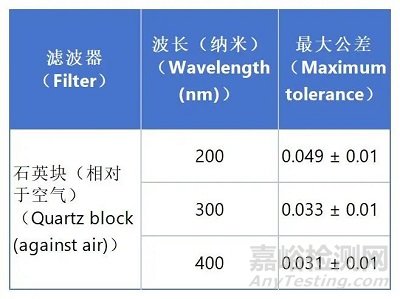
Photometric Drift
光度漂移
Photometric drift should be checked at both the visible and UV region, at appropriate wavelengths. The limits are in accordance with the user's requirements (as defined in Level I) and with manufacturer's specifications.
光度漂移应在可见光和紫外光区域的适当波长下进行检查。其限度应符合用户要求(如一级所定义)和制造商的规格。
For this test, 2 alternative examples are proposed.
对于此测试,提出了两个替代示例。
TEST 1
测试 1
Method:
方法:
As routine test, the drift is measured at 250 nm over a period of 2 hours by using the Time Scan mode of the instrument, with no sample in the sample chamber.
作为常规测试,在样品室无样品的情况下,使用仪器的时间扫描模式在 250 纳米波长下测量 2 小时内的漂移。
Limits: ± 0.001 Absorbance units/h
限度:±0.001 吸光度单位 / 小时
Note: In certain cases, for example when several samples are measured over a long period of time (or when using auto sampler), the drift can also be determined at the wavelength reported in the analytical method, under the same operational conditions, before testing samples.
注意:在某些情况下,例如在长时间测量多个样品时(或使用自动进样器时),也可以在测试样品之前,在相同操作条件下,在分析方法中报告的波长处测定漂移。
TEST 2
测试 2
Method.
方法
Record the baseline for 60 minutes at 500 nm and compare the absorbance with the initial value.
在 500 纳米处记录 60 分钟基线,并将吸光度与初始值进行比较。
Limits: ± 0.002 Absorbance units/h
限度:±0.002 吸光度单位 / 小时
Level IV. In - use instrument checks
IV 级 使用中仪器检查
This Annex contains practical examples of tests and their associated acceptance limits for several parameters related to the performance of an UV - Visible spectrophotometer. These examples can be considered by the OMCLs as possible approaches to perform the Level IV of the equipment qualification process: “In - use instrument checks”.
本附录包含了与紫外 - 可见分光光度计性能相关的几个参数的测试实例及其相关的可接受限度。这些实例可被官方药品控制实验室(OMCLs)视为执行设备确认过程 IV 级 “使用中仪器检查” 的可行方法。
SYSTEM SUITABILITY TEST OF THE METHOD
方法的系统适用性测试
REPEATABILITY (for quantitative analysis)
重复性(用于定量分析)
RESOLUTION (for both qualitative and quantitative analysis)
分辨率(用于定性和定量分析)
Method:
方法:
This test should be performed according to Ph. Eur., the MAH dossier or a suitably validated in - house method.
此测试应根据《欧洲药典》、上市许可持有人(MAH)档案或经过适当验证的内部方法进行。

来源:GMP办公室


